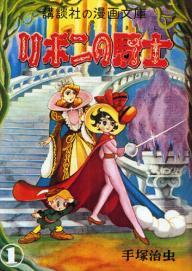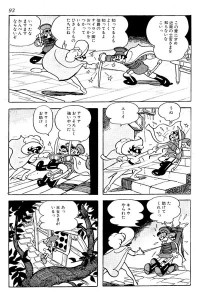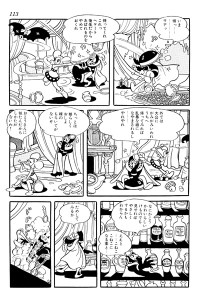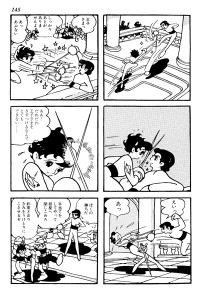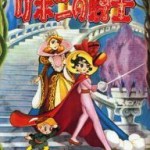Princess Knight [Shojo Club] (Manga)
Also known as リボンの騎士 [少女クラブ] (Ribon no Kishi [Shojo Kurabu])
| English Title: | Princess Knight [Shojo Club] |
| In English? | Yes* |
| Japanese Title: | リボンの騎士 (少女クラブ) Ribon no Kishi (Shojo Kurabu) |
| Type: | Ongoing Serial |
| Original run: | 1953/01 – 1956/01 |
| Published in: | Shojo Club
少女クラブ |
| Published by: | Kodansha |
| Volumes: | 2 |
The original manga adventure of Princess Knight was serialized in Shojo Club from January 1953 to January 1956 – with a one-off Princess Knight side-story (“Tink and the Golden Egg”) appearing in the Shojo Club “Summer Vacation Special Issue” in 1954. It was so successful, it spawned a sequel, known as The Twin Knights (1958-59), as well as a remake, known as Princess Knight [Nakayoshi] (1963-66).
What it’s about
Set in a medieval fairy-tale type setting, this is the story of young Princess Sapphire. When Sapphire is in heaven waiting to be born, a mischievous cherub named Tink accidentally gives her a second heart, and the young girl is born with both the brave and adventurous blue heart of a boy, as well as the loving and caring red heart of a girl. Realizing a mistake has been made, God sends Tink to earth with instructions to retrieve the blue boy’s heart. However, Princess Sapphire has been born into the Kingdom of Silverland, where only a male heir can inherit the throne, so retrieving the boy’s heart is no easy task. In order to keep the evil Duke Duralumin from becoming next-in-line to the throne, the king and queen announce that a prince has been born – forcing Sapphire into a life of deception.
For the first twelve years, things proceed relatively well, with Sapphire receiving training in the manly arts in public and the womanly arts in private. However, she is constantly on the lookout, side-stepping traps set by Duke Duralumin and his associate, Lord Nylon, in an attempt to confirm their suspicions that “he” is really a “she”. However, after one of Lord Nylon’s traps goes sideways during the carnival, the king dies in an accident and young Prince Franz Charming, from the neighboring Kingdom of Goldland, is accused of murder and taken into custody.
“Tezuka’s signature style of drawing shimmering stars in the pupils of the character’s eyes…”
This sets off a series of events that sees Sapphire “disguise” herself as a girl to break her new-found love out of jail and be nearly crowned as King, only to have her secret exposed and be banished from the kingdom – with Duralumin’s dimwit son Plastic installed as King in her stead. Taking the identity of the Princess Knight, Sapphire fights to save her mother, her prince (who still thinks she’s a man), and her very own “girl’s heart” from the clutches of the evil Mephisto, who wants to make his tomboyish daughter Hecate more feminine by any means necessary. Along the way, she gets turned into a swan, makes a deal with the devil, regains her throne, has her country invaded, becomes a wandering troubadour, and negotiates with the Queen of the Sea for her mother’s life.
Will she and Franz ever get married?
What you should know
Although Princess Knight [Shojo Club] (1953-56) is often called the first girls’ manga (shōjo) printed in Japan, this is not the case. In fact, it is not even Tezuka’s first attempt – both The Four Fencers of the Forest (1948) and The Story of a Miracle Forest (1949) predate Princess Knight [Shojo Club] (1953-56) by a few years and establish many of the themes he later explores more fully. However, Princess Knight [Shojo Club] (1953-56) was the realization of one of Osamu Tezuka’s long-held dreams – to create a romantic adventure story for young girls. This desire stemmed from his youth in the town of Takarazuka, and many of the themes in his girls’ manga (including Princess Knight) can be directly traced to the Takarazuka Revue – the all-female theatre troupe known for performing romantic plays, often based on Western fairy tales. Even Tezuka himself admitted in the Afterword to the Osamu Tezuka Complete Manga Works edition (MT-006) that his manga for girls, in particular, contains great nostalgia towards Takarazuka (1977, p. 258).
However, the overall look and feel of Princess Knight [Shojo Club] (1953-56) was also heavily influenced by two films first released in Japan in 1952; one being the 1937 Walt Disney animated classic, Snow White and the Seven Dwarfs, and the other the 1951 British film entitled The Tales of Hoffmann. In order to achieve a similar romantic and somewhat dreamlike quality to the setting, Princess Knight [Shojo Club] (1953-56) was printed with the first three pages in 3-colour, and the next four pages in 2-colour. The artwork was supplemented by Tezuka’s signature style of drawing shimmering stars in the pupils of the character’s eyes. When these (at the time) innovative techniques were combined with his tried-and-true cinematic adventure style, Princess Knight [Shojo Club] (1953-56) set the standard for girls’ manga in Japan.
In fact, it was so successful, it spawned both a direct sequel, with The Twin Knights (1958-59), carrying on the story of Sapphire‘s and Franz‘s children, as well as a remake, known as Princess Knight [Nakayoshi] (1963-66) – the version of the story most people are now familiar with.
Where you can get it
Princess Knight [Shojo Club] (1953-56) was published over two volumes as part of the Osamu Tezuka Complete Manga Works (MT-085 and MT-086). However, to be complete, the one-off Princess Knight side-story “Tink and the Golden Egg” can be found in the volume entitled The Story of Tonkara Valley (MT-382).
Although there are no complete English-language editions of Princess Knight [Shojo Club] (1953-56) , VIZ Media did print several pages in an excerpt in the July 2007 issue of its monthly anthology Shojo Beat.
What else you should check out
For chapter summaries and more in-depth information on the original publication, please check out the link below.

